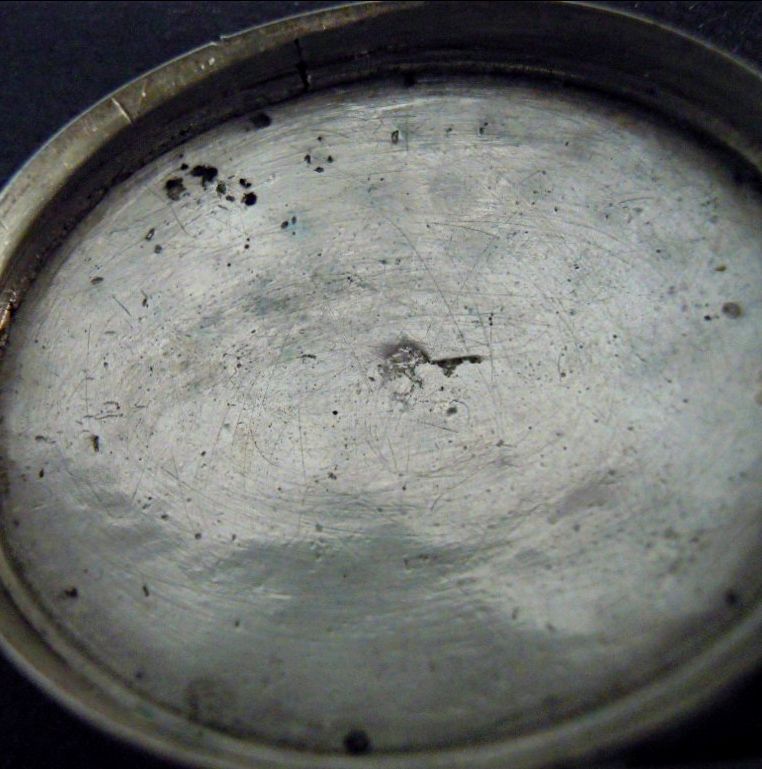In his Aeneas Ryan Blog (named after 18th century Dublin silver box maker, Aeneas Ryan), GCdS considers Bennett's comments and conjectures that the reason Dublin nutmeg graters are so rare compared to London is possibly different eating and drinking habits between the two capitals. This seems to be a topic that needs more research. His articles on Irish and in particular, Dublin nutmeg graters, are worth a read and include an interesting discourse on the rarity of Irish nutmeg graters.
http://aeneasryan.blogspot.ie/search/la ... g%20grater
The maker's mark SM on this nutmeg grater is believed to be that of a mid 18th century silversmith working in Cork or perhaps Kinsale. While it is not the rarely seen SM maker's mark attributed by Douglas Bennett to Cork silversmith, Stephen Mackrill (Mackerill) in his 1984 book Collecting Irish Silver, it may be another of his marks or it could be an as yet unidentified silversmith. It is not really a concern of mine as either way it is quite a rare item. It measures 4.2cm x 3.6cm x 2.3cm.
Bennett assumes Mackrill was a Scotsman who worked in Cork for a short period from 1759 but this period seems incorrect as Mackerill is mentioned as witnessing the marriage articles of Carden Terry's older sister, Jane, to Clonmel silversmith, Hercules Morgan, on the 14th February 1954, so clearly he was working in Cork well before 1759. Westropp says 1743-1763 and Cork Silver and Gold mentions he died in 1763. Bennett corrected the dates to agree with Westropp in his 1984 book Collecting Irish Silver.
Bennett shows photographs of two items of Mackrill's work in Irish Georgian Silver, a silver bowl and a cream jug but no photographs of the maker's mark. Bonhams sold an 18th century Irish Provincial silver-mounted cowrie shell snuff box, maker's mark only, which they attribute probably to Stephen Mackrill, but do not show a photograph of the actual mark. Being a snuff box, it may very well be the same SM as on the nutmeg grater. http://www.bonhams.com/auctions/18895/lot/2/
Two letters in 1908 and 1925 by M.S. Dudley Westrop (curator of the National Museum of Ireland during the early decades of the 20th century and an advisor to Jackson on Irish silver) refer to the SM mark. In the first letter, Westropp says SM may be Stephen Mackrill and in the second letter, he seems to cast some doubt on the Freedom Box being by Stephen Mackerill. Westropp uses Mackrill in the first letter and Mackerill in the second.
The 1908 letter:
DUBLIN MUSEUM,
KILDARE STREET,
Dublin, June 12th 1908
My dear Lane,
Very many thanks for letting me see the spoon. As far as I can make it out, I think it is a bird’s head erased, with mouth open, thus; - *. I should say that it is probably Scottish as numerous similar marks were used provincially in Scotland. The shape of the spoon is more like Scotland than Ireland.
I have got several more Cork goldsmiths lately. The ‘SM’ on your cream jug dated 1759 may be Stephen Mackrill mentioned in 1743. I also got two others of which I have marks and had no means to fit them before, ‘SB’ Stephen Broughton 1746 and ‘RP’ Robert Potter 1750. I found that John Mawman was a pewterer not a goldsmith.
I hope you are quite well now,
Yours sincerely,
Dudley Westropp
The 1925 letter:
National Museum of Ireland
Kildare Street
Dublin
Jan 27th 1925
My dear Lane,
Very many thanks for your letter. Curiously enough I had seen the ‘SM’ freedom box here. The arms are those of Dublin. I put the date somewhere about 1750 or 60 or perhaps later. I could find no freedom given to any Heron. I can find no Dublin Silversmith of these initials in the late 18th century. There was Stephen Mackerill of Cork 1743-63, but why should a Dublin freedom box be made in Cork? Perhaps Mackerill was in Dublin before he came to Cork, but that looks too early for the box. If you have an exact drawing or rubbing of the George Hodder mark of 1754.
I would be glad of a copy, as these dated marks help in other cases.
Yours sincerely,
Dudley Westropp
Stephen Mackrill does not appear in Cecil C. Woods article The Goldsmiths of Cork published in THE JOURNAL of the Royal Society of Antiquaries of Ireland, 1895. Likewise, in his article The Goldsmiths of Cork published by the Cork Historical and Archaeological Society, 1906, Westropp does not mention Stephen Mackrill in his list of makers so it seems he came to Westropp's attention between 1906 and 1908. The 1759 cream jug mentioned by Westropp is undoubtedly the one shown by Bennett in Irish Georgian Silver, which has a 1759 inscription on it. It's quite possible the SM mark on the Freedom box mentioned by Westropp in his 1925 letter is also the same as the nutmeg grater and not the cream jug as silver box making is a somewhat specialised craft. Unfortunately Westropp does not say if the SM marks were the same or different. However, I am advised that there are other Irish Provincial boxes with the same SM mark as the nutmeg grater and hope to see a photo soon.
The nutmeg grater is of the typical Irish oval low dome shape. The maker's mark on the inside of each lid is a bit worn or perhaps was not punched too hard. The S is clearer on one lid and the M on the other so I have created a composite SM mark in Photoshop to show it better. There is a dome above the initials with markings that I can't quite make out what they represents and is that a pellet between the initials or part of what is in the dome? The inscription on the top is a bit worn but looks like Gf.
If anyone can add any information to the SM maker's mark, please do.
Gordon







